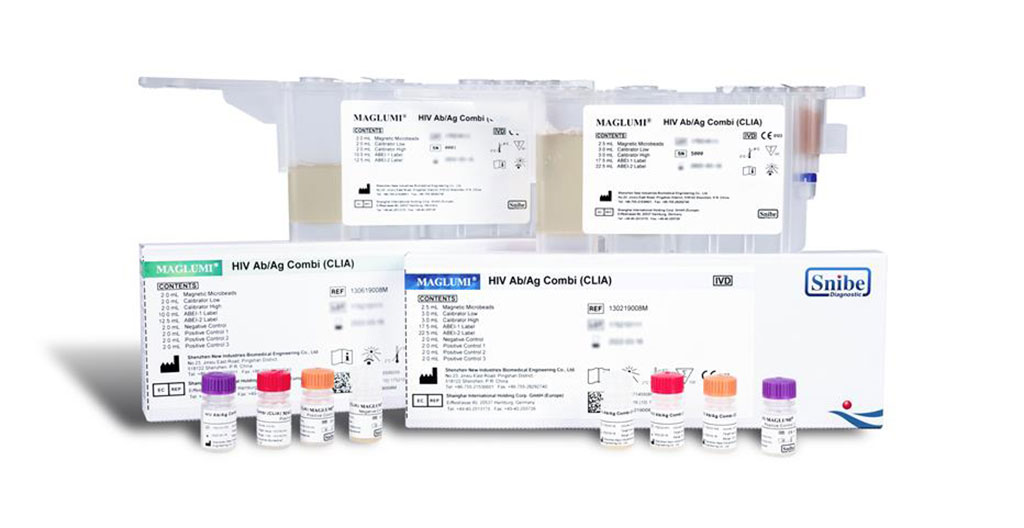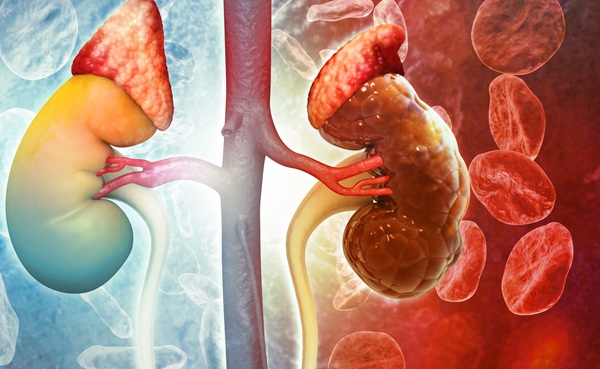Snibe Diagnostic’s Maglumi HIV Ab/Ag Combi CLIA Assay (4th-Generation) Secures CE Mark (List A)
|
By LabMedica International staff writers Posted on 16 Apr 2021 |

Image: Snibe Diagnostic’s Maglumi HIV Ab/Ag Combi CLIA Assay (4th-Generation) Secures CE Mark (List A) (Photo courtesy of Snibe Diagnostic)
Snibe Diagnostic (Shenzhen, China) has received the CE certificate (List A) for the Maglumi HIV Ab/Ag Chemiluminescence Immunoassay (CLIA) assay.
CE List A is the highest level of CE certification, which requires that the entire product performance verification process needs to be independently completed in Europe by a third party, and the results also need to be compared with the excellent products of the EU. It indicates that Maglumi HIV Ab/Ag Combi CLIA kit has totally met EU standards of performance, quality and safety, and can be sold in European markets.
HIV, or the human immunodeficiency virus, remains a major global public health problem, killing nearly 33 million people to date. Early diagnosis plays an essential role in the effective treatment of HIV and in increasing the survival rate of HIV patients. In the early stage of infection, the infected person usually has no specific clinical manifestations, and the HIV cannot be detected by conventional antibody detection methods, resulting in further spread of the virus. Adopting effective methods to detect early-stage infections and providing intervention and treatment are of great significance to individual and public health.
The US CDC’s laboratory testing guideline reports that HIV-1 p24 antigen is expressed and quantities rise to a level that can be detected by 4th generation immunoassays within four to 10 days after the initial detection of HIV-1 RNA. Next, immunoglobulin (Ig) M antibodies are expressed which can be detected by 3rd and 4th generation immunoassays three to five days after p24 antigen is first detectable, 10 to 13 days after the appearance of viral RNA.
The Maglumi HIV Ab/Ag Combi CLIA assay is the 4th generation HIV assay, which can reduce the detection window period by detecting not only HIV-1/2 antibodies but also the p24 antigen. The assay has an excellent clinical performance validated by the third-party independent laboratory in Germany, including: 100% clinical sensitivity for the positive samples of HIV-1 p24, Anti-HIV-1 and Anti-HIV-2; 99.98% clinical specificity for blood donor samples; equal or more sensitive than most commercial assays in the seroconversion panels detection; analytical sensitivity of 0.7695 IU/mL when testing the NIBSC HIV-1 p24 antigen (NIBSC code: 90/636, ≤ 2.0 IU/mL); no cross-reaction with common potential interferent; validated different types of sample collecting tube; and capability to detect various groups of HIV.
Related Links:
Snibe Diagnostic
CE List A is the highest level of CE certification, which requires that the entire product performance verification process needs to be independently completed in Europe by a third party, and the results also need to be compared with the excellent products of the EU. It indicates that Maglumi HIV Ab/Ag Combi CLIA kit has totally met EU standards of performance, quality and safety, and can be sold in European markets.
HIV, or the human immunodeficiency virus, remains a major global public health problem, killing nearly 33 million people to date. Early diagnosis plays an essential role in the effective treatment of HIV and in increasing the survival rate of HIV patients. In the early stage of infection, the infected person usually has no specific clinical manifestations, and the HIV cannot be detected by conventional antibody detection methods, resulting in further spread of the virus. Adopting effective methods to detect early-stage infections and providing intervention and treatment are of great significance to individual and public health.
The US CDC’s laboratory testing guideline reports that HIV-1 p24 antigen is expressed and quantities rise to a level that can be detected by 4th generation immunoassays within four to 10 days after the initial detection of HIV-1 RNA. Next, immunoglobulin (Ig) M antibodies are expressed which can be detected by 3rd and 4th generation immunoassays three to five days after p24 antigen is first detectable, 10 to 13 days after the appearance of viral RNA.
The Maglumi HIV Ab/Ag Combi CLIA assay is the 4th generation HIV assay, which can reduce the detection window period by detecting not only HIV-1/2 antibodies but also the p24 antigen. The assay has an excellent clinical performance validated by the third-party independent laboratory in Germany, including: 100% clinical sensitivity for the positive samples of HIV-1 p24, Anti-HIV-1 and Anti-HIV-2; 99.98% clinical specificity for blood donor samples; equal or more sensitive than most commercial assays in the seroconversion panels detection; analytical sensitivity of 0.7695 IU/mL when testing the NIBSC HIV-1 p24 antigen (NIBSC code: 90/636, ≤ 2.0 IU/mL); no cross-reaction with common potential interferent; validated different types of sample collecting tube; and capability to detect various groups of HIV.
Related Links:
Snibe Diagnostic
Latest Immunology News
- Blood Test Could Detect Adverse Immunotherapy Effects
- Routine Blood Test Can Predict Who Benefits Most from CAR T-Cell Therapy
- New Test Distinguishes Vaccine-Induced False Positives from Active HIV Infection
- Gene Signature Test Predicts Response to Key Breast Cancer Treatment
- Chip Captures Cancer Cells from Blood to Help Select Right Breast Cancer Treatment
- Blood-Based Liquid Biopsy Model Analyzes Immunotherapy Effectiveness
- Signature Genes Predict T-Cell Expansion in Cancer Immunotherapy
- Molecular Microscope Diagnostic System Assesses Lung Transplant Rejection
- Blood Test Tracks Treatment Resistance in High-Grade Serous Ovarian Cancer
- Luminescent Probe Measures Immune Cell Activity in Real Time
- Blood-Based Immune Cell Signatures Could Guide Treatment Decisions for Critically Ill Patients
- Novel Tool Predicts Most Effective Multiple Sclerosis Medication for Patients
- Companion Diagnostic Test for CRC Patients Identifies Eligible Treatment Population
- Novel Tool Uses Deep Learning for Precision Cancer Therapy
- Companion Diagnostic Test Identifies HER2-Ultralow Breast Cancer and Biliary Tract Cancer Patients
- Novel Multiplex Assay Supports Diagnosis of Autoimmune Vasculitis
Channels
Clinical Chemistry
view channel
POC Breath Diagnostic System to Detect Pneumonia-Causing Pathogens
Pseudomonas aeruginosa is a major cause of hospital-acquired and ventilator-associated pneumonia, particularly in lung transplant recipients and patients with structural lung disease. Its ability to form... Read more
Online Tool Detects Drug Exposure Directly from Patient Samples
Doctors often rely on patient interviews and medical records to determine what medications a person has taken, but this information is frequently incomplete. People may forget drugs they used, take over-the-counter... Read moreMolecular Diagnostics
view channel
Blood Biomarker Improves Early Brain Injury Prognosis After Cardiac Arrest
After a cardiac arrest, many patients remain unconscious for days, leaving doctors and families facing uncertainty about whether meaningful recovery is possible. Current tools to assess brain damage, including... Read more
Biomarkers Could Identify Patients at High Risk of Severe AKI After Major Surgery
Acute kidney injury is one of the most common and dangerous complications after major surgery, particularly among patients in intensive care. Even mild impairment of kidney function can lead to long-term... Read more
CLIA Test Identifies Head and Neck Cancer Recurrence from Post-Surgical Lymphatic Fluid
While the lymphatic system’s critical role in metastasis has long been recognized, routine access to patient lymph has been elusive. Now, a non-invasive process can access lymph through the collection... Read moreHematology
view channel
MRD Tests Could Predict Survival in Leukemia Patients
Acute myeloid leukemia is an aggressive blood cancer that disrupts normal blood cell production and often relapses even after intensive treatment. Clinicians currently lack early, reliable markers to predict... Read more
Platelet Activity Blood Test in Middle Age Could Identify Early Alzheimer’s Risk
Early detection of Alzheimer’s disease remains one of the biggest unmet needs in neurology, particularly because the biological changes underlying the disorder begin decades before memory symptoms appear.... Read more
Microvesicles Measurement Could Detect Vascular Injury in Sickle Cell Disease Patients
Assessing disease severity in sickle cell disease (SCD) remains challenging, especially when trying to predict hemolysis, vascular injury, and risk of complications such as vaso-occlusive crises.... Read more
ADLM’s New Coagulation Testing Guidance to Improve Care for Patients on Blood Thinners
Direct oral anticoagulants (DOACs) are one of the most common types of blood thinners. Patients take them to prevent a host of complications that could arise from blood clotting, including stroke, deep... Read moreMicrobiology
view channel
Blood-Based Diagnostic Method Could Identify Pediatric LRTIs
Lower-respiratory tract infections (LRTIs) are a leading cause of illness and death worldwide, and pneumonia is the leading infectious cause of death in children under five, claiming the lives of over... Read more
Rapid Diagnostic Test Matches Gold Standard for Sepsis Detection
Sepsis kills 11 million people worldwide every year and generates massive healthcare costs. In the USA and Europe alone, sepsis accounts for USD 100 billion in annual hospitalization expenses.... Read moreRapid POC Tuberculosis Test Provides Results Within 15 Minutes
Tuberculosis remains one of the world’s deadliest infectious diseases, and reducing new cases depends on identifying individuals with latent infection before it progresses. Current diagnostic tools often... Read more
Rapid Assay Identifies Bloodstream Infection Pathogens Directly from Patient Samples
Bloodstream infections in sepsis progress quickly and demand rapid, precise diagnosis. Current blood-culture methods often take one to five days to identify the pathogen, leaving clinicians to treat blindly... Read morePathology
view channel
Rapid Low-Cost Tests Can Prevent Child Deaths from Contaminated Medicinal Syrups
Medicinal syrups contaminated with toxic chemicals have caused the deaths of hundreds of children worldwide, exposing a critical gap in how these products are tested before reaching patients.... Read more
Tumor Signals in Saliva and Blood Enable Non-Invasive Monitoring of Head and Neck Cancer
Head and neck cancers are among the most aggressive malignancies worldwide, with nearly 900,000 new cases diagnosed each year. Monitoring these cancers for recurrence or relapse typically relies on tissue... Read more
Common Health Issues Can Influence New Blood Tests for Alzheimer’s Disease
Blood-based tests for Alzheimer’s disease are transforming diagnosis by offering a simpler alternative to spinal taps and brain imaging. However, many people evaluated at memory clinics also live with... Read more
Blood Test Formula Identifies Chronic Liver Disease Patients with Higher Cancer Risk
Chronic liver disease affects millions worldwide and can progress silently to hepatocellular carcinoma (HCC), one of the deadliest cancers globally. While surveillance guidelines exist for patients with... Read moreTechnology
view channel
Machine Learning Models Diagnose ALS Earlier Through Blood Biomarkers
Amyotrophic lateral sclerosis (ALS) is a rapidly progressive neurodegenerative disease that is notoriously difficult to diagnose in its early stages. Early symptoms often overlap with other neurological... Read more
Artificial Intelligence Model Could Accelerate Rare Disease Diagnosis
Identifying which genetic variants actually cause disease remains one of the biggest challenges in genomic medicine. Each person carries tens of thousands of DNA changes, yet only a few meaningfully alter... Read moreIndustry
view channel
BD and Penn Institute Collaborate to Advance Immunotherapy through Flow Cytometry
BD (Becton, Dickinson and Company, Franklin Lakes, NJ, USA) has entered into a strategic collaboration with the Institute for Immunology and Immune Health (I3H, Philadelphia, PA, USA) at the University... Read more







 assay.jpg)










